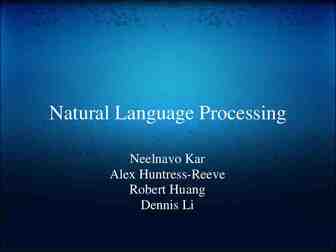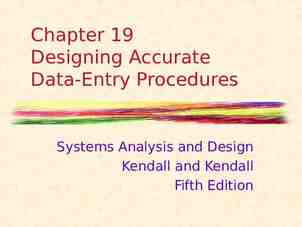FINANCIAL AID College of Medicin e
40 Slides1.65 MB

FINANCIAL AID College of Medicin e

APPLYING FOR FINANCIAL AID FAFSA Application: www.fafsa.ed.gov (UTHSC School code: 006725) FAFSA Opens - each school year (October 1st)

2018-19 INTEREST RATE Direct Unsubsidized Loans Direct PLUS Loans Graduate or Professional Graduate or Professional Students 6.6% 7.6% All interest rates shown in the chart above are fixed rates that will not change for the life of the loan.

STEPS TO COMPLETE ACCEPT AWARD ENTRANCE COUNSELING MASTER PROMISSORY NOTE TUITION/FEES PAID REFUND DISBURSED

ACCEPT AWARD To view your awards, follow these 5 steps: Login to Banner Self-Service Click on Financial Aid Next, click on Award Award for Aid year and select year Accept the Terms and Conditions Lastly, you should click on Accept Award Off er * NOTE: When accepting awards, you are accepting for the entire year and not just for the term.

ENTRANCE COUNSELING Sign in to StudentLoans.go v using your Federal Student Aid PIN Select "Entrance Counseling"

Master Promissory Note (MPN) Includes your rights and responsibilities as a borrower and it’s the legal document all student loan borrowers must complete promising to repay the loan. Unsubsidized & Graduate Plus each year!

BANNER SELF-SERVICE Direct Deposit Refunds Setup for Students 1.Go to: Banner Self-Service 2. Enter Your Net ID and Password. 3. At the Main Menu, click on Student. 4. On the Student menu, click on Student Account. 5. Click on Account Summary. 6. Next, click on Pay Your Fees. 7. Click on eRefunds and follow instructions to set up account.

REFUND DISBURSEMENT Financial aid must fi rst pay a student's tuition and fees each term. If excess funds remain after paying these expenses, the student is sent a fi nancial aid refund to help them pay for their books and living expenses. All refunds are direct deposited to your checking account or mail.

ONE ON ONE COUNSELING ALL M1 incoming students are required to schedule and complete a one-on-one counseling session with their Financial Aid Counselor. Must complete counseling – Student will not be able to register for Spring 2019 term. Offi ce Visit Phone MANDATORY!!!

TYPES OF LOANS Direct Unsubsidized Loan Direct Graduate Plus Loan Private/Alternative Loan

DIRECT UNSUBSIDIZED LOAN 42,722 (Unsubsidized) 6.60% Interest rate No payments while in school Interest accrual daily after disbursement Payments begin six months after graduation

DIRECT GRADUATE PLUS LOAN Eligibility is the diff erence between your Cost of Attendance (COA) Budget MINUS other aid being received 7.60% interest rate No payments while in school Interest accrual daily after disbursement Payments begin six months after graduation Where to apply: http://www.uthsc.edu/fi naid/forms.php

Cost of Attendance

2018-2019 I N - S TAT E C O S T O F AT T E N D A N C E E S T I M AT E Tuition/Fees 35,006 Books and Supplies 1,750 Living Expenses 21,770 Total 58,526

2018-2019 OUT- OF-STATE COST OF ATTENDANCE ESTIMATE Tuition/Fees 68,098 Books and Supplies 1,750 Living Expenses 21,770 Total 91,618

IN-STATE PACKAGING EXAMPLE COA 58,526 42,722 Direct Unsubsidized Loan 15,804 Graduate PLUS Loan 58,526 *Scholarships/Institutional waivers will decrease loan amounts

OUT-OF-STATE PACKAGING EXAMPLE COA 91,618 42,722 Direct Unsubsidized Loan 48,896 Graduate PLUS Loan 91,618 * Scholarships/Institutional waivers will decrease loan amounts

Budgeting

CREATE A BUDGET A budget is a plan for your future income and expenses that you can use as a guideline for spending and saving. A good monthly budget can help ensure you are borrowing only what you need while in-school. http://uthsc.edu/financial-aid/flight/budgeting.php

BUDGETING APPS The market leader in budgeting management The app automatically updates and syncs with user accounts to categorizes transactions, creating a track spending picture of spending in real time. Free iOS, Android Get started It crunches the numbers to show how much money is available after accounting for bills, spending and savings goal contributions. All users can view how much money is left “in their pocket” for the day, week or month. PocketGuard gives users a snapshot of how much they can spend at any given moment Free iOS, Android Get started

CREDIT BUREAUS o o o o o o o Equifax www.equifax.com 1-800-525-6285 Experian www.experian.com 1-888-397-3742 Transunion www.transunion.com 1-800-680-7289 **Free credit report authorized by the Federal Trade Commission: www.annualcreditreport.com www.CreditKarma.com

Student Loan History

ORIGINATION FEE Origination fee - An amount, usually calculated as a percentage of a loan, which a lender charges for processing your application. Loan Type First Disbursement Date Loan Fee Direct Subsidized Loans and Direct Unsubsidized Loans On or after 10/1/18 and before 10/1/19 1.062% On or after 10/1/17 and before 10/1/18 1.066% Direct PLUS Loans On or after 10/1/18 and before 10/1/19 4.248% On or after 10/1/17 and before 10/1/18 4.264%

CREDIT CHECK WITH GRADUATE PLUS LOAN Requires a credit check as part of the application process You cannot have any adverse credit history - Obtain an endorser Your credit is evaluated every time you request a new PLUS loan - after 180 days

NSLDS – LOAN HISTORY The National Student Loan Data System (NSLDS) is the U.S. Department of Education's (ED's) central database for student aid. NSLDS receives data from schools, guaranty agencies, the Direct Loan program, and other Department of ED programs. NSLDS Student Access provides a centralized, integrated view of Title IV loans and grants so that recipients of Title IV Aid can access and inquire about their Title IV loans and/or grant data.

NSLDS.ED.GOV View your federal student aid history Get your loan servicer’s contact information Download your federal student aid history into a text file using the MyData Download function Establish an online account with Loan Servicing to track your loan history while school

UNDERSTANDING REPAYMENT PLANS Student borrowers may repay their student loans through one of the several repayment plans: Standard Repayment Graduate Repayment Income Base Repayment (IBR) Pay As You Earn (PAYEE)

STANDARD REPAYMENT PLAN Under this plan, the borrower will pay a fixed amount of at least 50 each month for up to 10 years. For most borrowers, this plan results in the lowest total interest paid because the repayment period is shorter than it would be under any of the other repayment plans. (Subsidized, Unsubsidized and PLUS Loans) Standard Repayment Graduate Repayment Income Base Repayment (IBR) Pay As You Earn (PAYEE)

GRADUATED REPAYMENT PLAN The Graduated Repayment Plan may be beneficial if the borrower’s income is low when they leave school but is likely to steadily increase. Under this plan, payments start out low and then increases every two years. Like the Standard Plan, the maximum repayment period is 10 years for Subsidized, Unsubsidized, and PLUS Loans. Standard Repayment Graduate Repayment Income Base Repayment (IBR) Pay As You Earn (PAYEE)

INCOME-BASED REPAYMENT Standard Repayment Under IBR, monthly payment is based on the borrower’s Adjusted Gross Income (AGI), family size, and state of residence. Graduate Repayment Income-Base Repayment (IBR) Pay As You Earn (PAYEE) Monthly payments are adjusted each year according to changes in your income and family size – ator l u c l a new application must be c , t act shee f R B I le on n b A a l i a v a is submitted . and Q&A .ed.gov dentAid u t S . w w w

PAYE – PAY AS YOU EARN New borrower - no outstanding balance on a Direct Loan or FFEL Program of federal loans. All undergraduate loans must be paid in full and cannot be consolidated Standard Repayment Graduate Repayment Income Base Repayment (IBR) Pay As You Earn (PAYEE)

POSTPONE PAYMENT You can receive a forbearance that allows you to temporarily postpone or reduce your federal student loan payments. Postponing or reducing your payments may help you avoid default. With forbearance, you may be able to stop making payments or reduce your monthly payment for up to 12 months. Interest will continue to accrue on your subsidized and unsubsidized loans (including all PLUS loans).

ACCRUED INTEREST Accrued interest is the amount of loan interest that is accruing while you are in-school, but has not yet been paid to the lender by the borrower. Capitalization - adding unpaid, accumulated interest to the principal balance of your loan. Capitalization increases the total cost of your loan.

PUBLIC SERVICE LOAN FORGIVENESS PROGRAM (PSLF ) Students can receive loan forgiveness through the Public Service Loan Forgiveness (PSLF) Program: Must make on-time, full monthly payments under the IncomeContingent Repayment, Pay As You Earn (PAYE) or Income Base Repayment (IBR) plans while employed full-time in public service job Must make 120 monthly payments that are required to receive loan forgiveness through the PSLF Program Employed full-time (30 hrs.) with a non-profit 501(c)3 organization, government, military, or public service organization For medical students, payments made during a full-time residency program can count toward your 120 required payments

ONE-STOP-SHOP Located in 910 Building on the 1 st floor Services available: Financial Aid Registrar Offi ce Admissions Residency

RESOURCES: Financial Literacy Newsletter: FLIGHT News Financial Literacy Website http://www.uthsc.edu/finaid/flight/index.php Facebook Page: UTHSC Flight Financial Literacy Library: (located in the One-Stop)

Questions & Answers

CONTACT INFORMATION Ms. Janice G. Maddox, MBA Coordinator, Financial Literacy One Stop Shop (901) 448-1601 [email protected] Skype: Janice.maddox3







